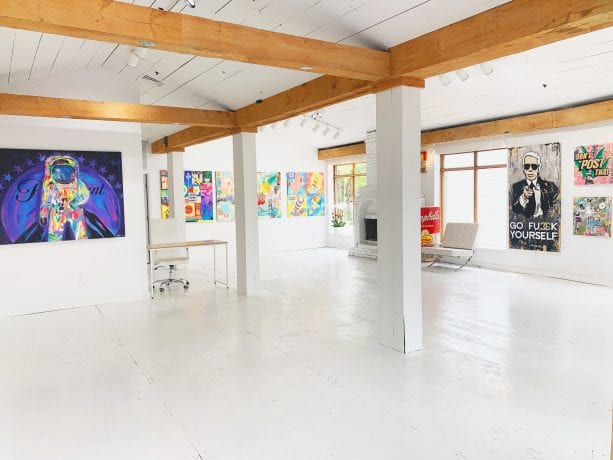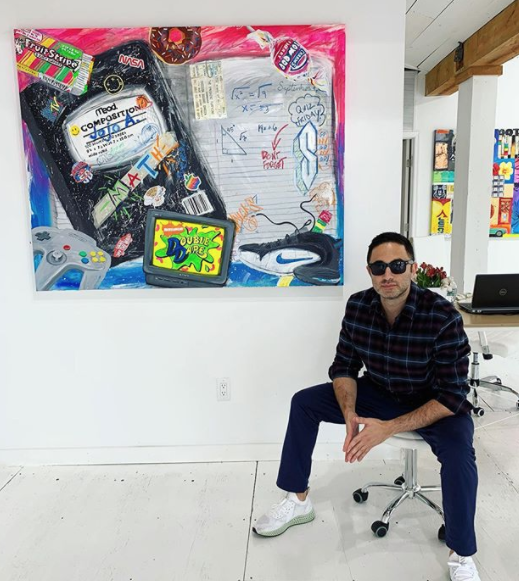He’s been called the “Andy Warhol of the Snapchat generation,” but mixed media contemporary artist and area native Joseph “Jojo” Anavim says he’s loath to accept most praise, or even call himself a pop artist.
“I am by nature a very humble person, meaning anytime I’m receiving praise, I just always kind of put my head down,” Anavim said in a recent interview. “And I think to myself that deep down, maybe I don’t deserve this.”
“This” would include selling his art for as much as $60,000; a litany of celebrity clients, including basketball players Amar’e Stoudemire and Carmelo Anthony, singer/actress Selena Gomez and financial heavy-hitters Sheldon Adelson and Daymond John; being the subject of two New York Times profiles and a short documentary by the New York Knicks; and having his work featured in his beloved Madison Square Garden, among other things.
Now, the artist is coming home, and for a few months will be exhibiting his art in a pop-up gallery on Old Northern Boulevard, not far from where he grew up in the Roslyn section of the Village of Flower Hill.

“On top of that, my parents had gotten me an Apple computer that through some bizarre promotion at the time, had Photoshop pre-installed on it,” Anavim said. “It was a very rare thing, I’ve come to find out, it was only like 1,000 computers. So just the odds of that are just so crazy. So I was toying with digital photo manipulation and photoshopping my friends and into very compromising situations, but we would all get a good laugh out of that.”
The combination of the training and the laptop would blend “in a very impressionable stage of my life,” Anavim says, but that still didn’t mean he would consider it as a career.
“For a while, it was just a hobby and no one ever said, ‘Oh, this is a good career option for you,'” Anavim said. “In fact, they were like, ‘Why would you ever do this? It’s the dumbest thing.'”
Taking a perceived practical route after his 2002 graduation from Roslyn High School (he says his only A+ came from a graphic design class), Anavim studied business at Hofstra University for a year until moving to Hunter College in Manhattan, graduating with a degree in psychology in 2006. He began working as a graphic designer, creating billboards for companies like Sephora and W Hotels, and album art for Universal Music Group’s recording artists, as well as art for numerous advertising campaigns.
“I had some great clients and I was doing really fun, large scale national projects,” Anavim said. “And then that kind of just naturally progressed into what I’m doing now.”
The influences from his graphic design days were carried over into his current works, he says.
“You’re working with color palettes, you’re working with typography, you’re working with different layers of images,” Anavim said. “It’s just that one is more executed by hand, and one is on more of a digital platform.”
Anavim’s modern style is encapsulated in his favorite piece in the Roslyn pop-up gallery. The 48×60 work comprises his entire 1990s experience, featuring images of a Nintendo 64 controller, Fruit Stripe gum, a TV showing Nickelodeon’s “Double Dare,” a ticket stub for a Smashing Pumpkins concert, and, in tribute to his first canvases, a composition book meant for math lessons but adorned with sketches and stickers.
“It really feels to me like I’ve transported myself back to 1996 or something like that with this,” Anavim said. “It’s just one year, it’s just a culmination of this blurry thing that I remember from late middle school, early high school.”
After a successful decade creating mixed media art, Anavim says he was mostly unprepared for the widespread change that COVID-19 would bring.
“At the start of the year, I was in the city, I was kind of just had my head down and was focusing on everything in Manhattan,” Anavim said. “And then we were all kind of locked down. We were all in our own heads and just trying to see, is at the end of the world, what’s gonna end up happening over here? That I didn’t really know, no one really knew.”
He adds that the pandemic also served as a “wake-up call” for him.
“It was kind of a time to zoom out, let’s see what’s really important,” Anavim said. “Let’s take a look at our lives. What were we consumed with as far as our day-to-day activities? And was that really worth all of what we’re doing now when this illusion of certainty can be suspended indefinitely.”
The “call” came in the months immediately following Manhattan becoming a COVID-19 epicenter, when Anavim returned to his parents’ home to quarantine.
“We just did simple things like meeting on a Tuesday afternoon at 3 p.m. and walking in the village of Roslyn or taking a ride out to Oyster Bay, just the simple things,” Anavim said. “Personally, I was taking it for granted, maybe I wasn’t even taking it at all, it was almost an afterthought. Before, I thought, OK, I’ve been there, what’s next? And then I came back, and I looked at it in this completely new lens. And it’s just so lovely, and so charming. There are just so many different facets to Roslyn.”
Over and over on his walks through the village, Anavim noticed that a space that used to house the pioneering farm-to-table restaurant Friend of a Farmer had been abandoned for 15 years. He adds that his mother, Ladan, was instrumental in getting him to open the gallery.
“I had this loose idea, like, oh, that’d be a cool place,” Anavim said. “It was kind of an afterthought like everything else – put it to the list and it’ll collect dust for years. And then my mom was the one that really kind of said, ‘Hey, what about that place? What about this place? Have you called that guy yet?’ And I said, all right, I’ll call him, and now I’m very happy that I did.”
Anavim contacted the property’s landlord and “made a little agreement” to rent for three months, with the option of a year. He says he has returned to Manhattan, but stays with his parents once or twice a week for gallery work, and that his mother “moonlights” at the gallery each week.
“I’m in the middle of those three months, right now, and we’re gonna see what ends up happening, but it’s generally been a very positive experience,” Anavim said. “The town is just so lovely.”
While he’s glad he has his gallery, Anavim says he knows fellow creatives who can’t work at their music venues or hold their showings in the pandemic.
“It’s a very tough time,” Anavim said. “But what I do know is that this: The worst thing for an artist’s creativity is the status quo, things just going as they were doesn’t spark any new ideas, doesn’t spark new creativity. One thing that I think is the silver lining specifically, and especially for creatives, is that this undoubtedly will spark a new era of creation, new bodies of work, it will inspire the artists and viewers to see things in a different way.
“I know that we’re going to look back 5, 10, 20 years from now at the work that was created this time, and it will, in my view, probably come to define a generation. So that I know it’s hard for some people to digest that now, because the bills are not going to get paid by saying what’s going to happen in 20 years, but that’s it. These are what spark the most radical change when it comes to the way that we look at things.”



